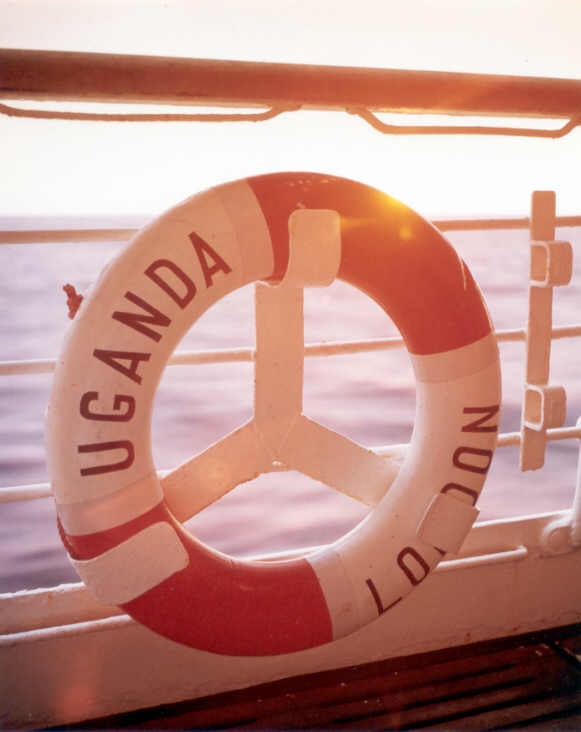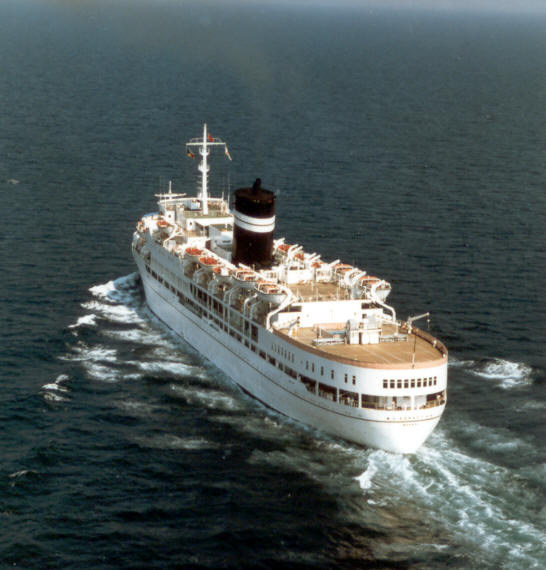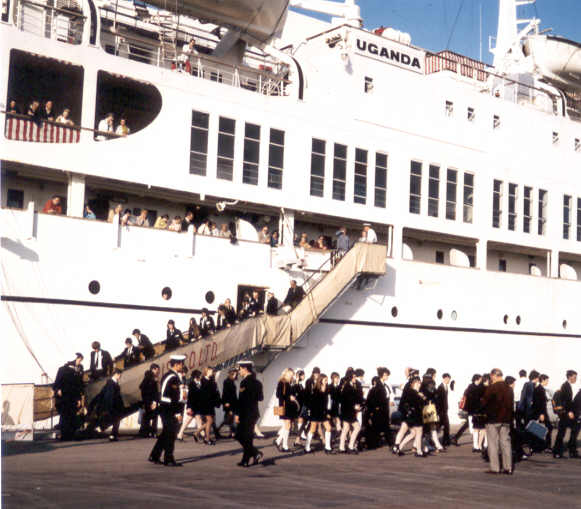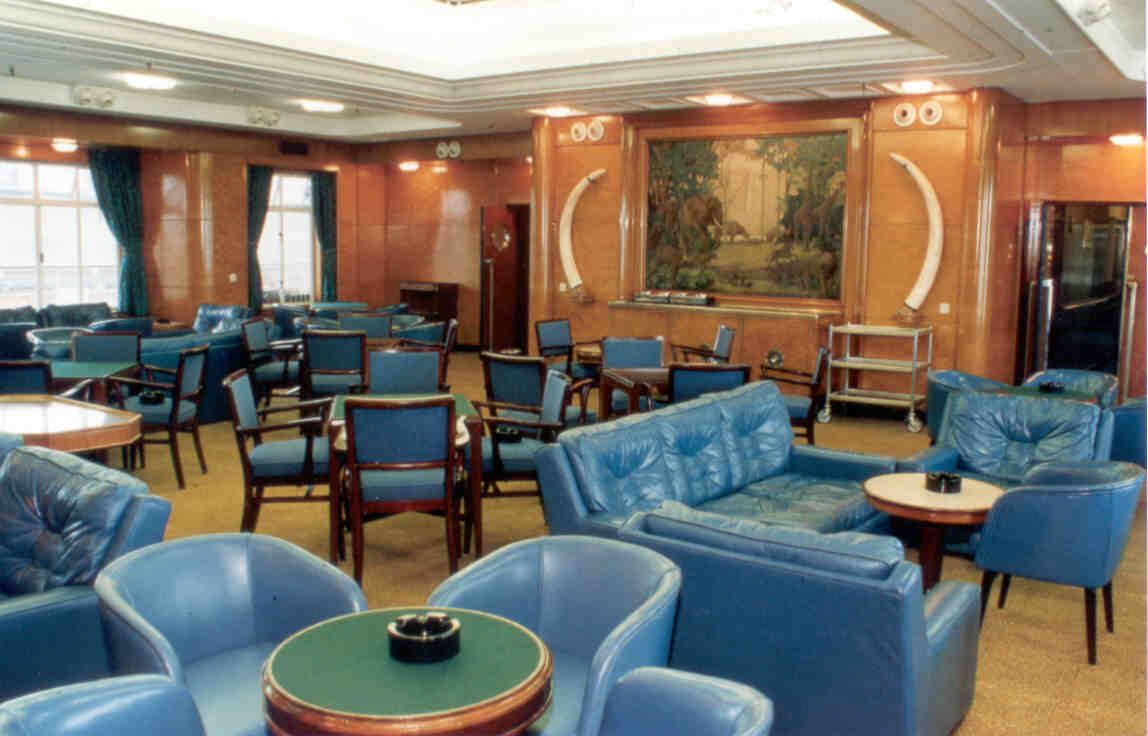How to order your copy of the SS Uganda book or SS Nevasa book
Schoolboy cruises were pioneered in the UK during the 1930's using troopships that were idle during the summer. Inevitably this venture was stopped by the Second World War and unfortunately it was not resumed when peace returned. However, when the Government announced that it would cease trooping by sea in 1960, the British India Steam Navigation Company Ltd. (known as B.I.) decided to convert one of its troopships, MS Dunera to a permanent educational cruise ship.
MS Dunera, of 11,162 tons and built in 1937, was converted to a floating school with dormitory accommodation for the pupils, classrooms, a lecture theatre/cinema, a library and deck space for sports, together with cabin accommodation for teachers and independent cabin passengers. She set off on her first cruise from Greenock on the 12th April 1961 and completed a further 14 cruises that year.
Although initial school bookings were poor, B.I. demonstrated their faith in the venture by introducing a second ship the following year. The MS Devonia, formerly the MS Devonshire of the Bibby Line, was a near sister of the MS Dunera. As the educational cruising scheme developed momentum, and pupils had time to save and/or earn money towards their fares, loadings improved and B.I. introduced their third and largest ship, the 20,527 ton SS Nevasa in 1965. Educational cruising reached its peak with around 60 cruises each year.
However, the MS Dunera and MS Devonia were both approaching 30 years of age and becoming expensive to maintain. Hence the decision to replace them with the SS Uganda that was becoming redundant on the company's East African service. In contrast with the three previous educational cruise ships, which were all former troopships with mess areas that needed relatively little modification to form dormitory accommodation, the SS Uganda required a major conversion. Work was carried out by Howaldtswerke AG at Hamburg. Most of her former cargo holds were converted to the student areas and the upper decks were extended to provide additional cabin accommodation. Moreover the quadrupling from around 300 passengers to a total of 1,200 students and cabin passengers necessitated a substantial increase in the galley, laundry, fresh water and electrical generation capacities. Her tonnage had increased from 14,430 to 16,607 tons.

A life belt catching the evening sun. Source: P&O Collection.
Under the command of Captain Eric Plowman, the SS Uganda emerged from Hamburg looking very much a new ship. A total of 785 students from Norfolk and Northumberland, together with 50 from Czechoslavakia, were embarked at Southampton on the 27th February 1968 for the maiden cruise that was to call briefly at Plymouth and then went on to Malaga, Piraeus, Istanbul, Heraklion and, finally, Genoa. A further 20 cruises were completed that year.
SS Uganda cruises through the English Channel in glorious weather. The main sports facilities for the students, including deck hockey and a swimming pool, were on the large open deck above the stern. The Students' Common Room, with large windows overlooking the stern, was on the deck below. Source: Courtesy of FotoFlite.
The SS Uganda soon became popular with her passengers, despite her slightly peculiar motion in heavy seas caused by the extra weight on her upper decks following the conversion. Together with the SS Nevasa, the two vessels, with their distinctive B.I. colours and each carrying around 900 students, soon became a familiar and welcome sight at many European ports.Students spend days at sea under the control of their teachers, known as party leaders. Activities included lessons during term time, port lectures, deck sports and writing up logs/diaries. Evening entertainment included a disco and a cinema. The party leaders were coordinated by the ship's headmaster and deputies, and the ship also had a staff of matrons and masters at arms to help with ailments and patrol the dormitories. In addition the ship had a well equipped hospital to handle more serious medical problems.
Days ashore were normally either spent on organised coach tours or on independent sight seeing when students would roam cities in groups of five. Summer cruises were mainly to Scandinavia, the Atlantic Islands and the Western Mediterranean while winter cruises were mainly in the Eastern Mediterranean. Initially travel to the Eastern Mediterranean was by train to ports such as Genoa, but this soon changed to charter flights to Venice, Naples, Athens and Malta.

Excited students disembark the SS Uganda at a port of call. School uniforms helped party leaders spot their pupils even in densely packed cities. Source: Marion Browning.
These cruises were often the first experience of foreign travel for students and the educational value was considerable. They could learn about history, geography, religions, foreign languages and currency, and sometimes witnessed poverty. Sites visited included the pyramids, the Parthenon, the apes of Gibraltar, glaciers, the midnight sun and the volcanic scenery of Lanzarote. In addition to the direct educational content, the cruises often improved relationships between teachers and pupils; indeed the teachers were often learning too.B.I. was absorbed into P&O in 1971. Most former B.I. ships were repainted in the P&O livery but the SS Uganda and the SS Nevasa were among the few that were allowed to retain B.I. colours, albeit with a P&O houseflag.
The oil crisis of 1973 increased the cost of marine fuel fourfold. This resulted in the early disposal of many traditional passenger liners, especially those with steam propulsion which was by now far less efficient than the marine diesel, and unfortunately one of these victims was the SS Nevasa. This much loved ship went off to Taiwan for demolition shortly after the end of her 1974 season, after just 18 years in service, leaving the SS Uganda as the only surviving UK educational cruise ship.
